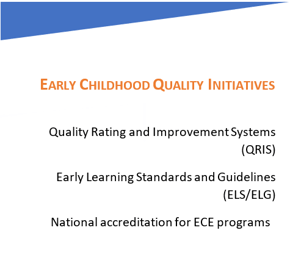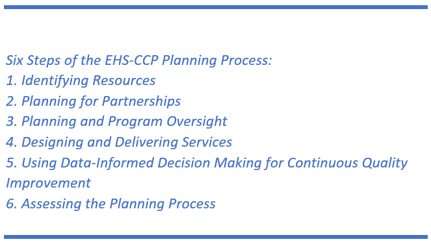One of Child Care Resource and Referral agencies (CCR&Rs) most important roles is to collect and help make sense of important data on child care needs and trends in their communities. Families, child care providers and stakeholders want to know the price of child care in their area as they explore options for their children, their program or their community. Individuals or stakeholders hoping to start a child care business often reach out to their local CCR&R to determine what the geographical area or community needs are before they move forward in opening a child care business. As CCR&Rs keep current on local, state and federal grants and opportunities in the field of early childhood, they are often sought out for information on underserved populations and child care deserts. CCR&Rs use the data to inform decision-making regarding child care needs and support the community in their efforts to address issues and capitalize on opportunities.
One such opportunity is the Early Head Start–Child Care Partnerships (EHS-CCP) program. It has become one of the solutions to the challenge of the underserved infant and toddler population in child care. Launched in 2014, EHS-CCP is a federally funded program that promotes local solutions, infuses resources into the under-resourced child care system and aligns early childhood services in communities. The EHS-CCP program is investing federal resources into local innovation to ensure that children and families have access to high-quality early care and learning so that children can thrive, and their parents can work to get ahead. Local CCR&Rs, leading early childhood quality efforts and already providing services, can provide practical information and valuable resources to the development of EHS-CCP efforts in their communities. CCR&Rs can play a role in facilitating the development of partnerships and contracted services which can strengthen both the child care and EHS program, as well as improve the overall quality of infant toddler care.
EHS programs that seek to collaborate with child care or use child care funds to extend service hours need to review, understand and incorporate child care requirements into planning and implementing quality servi ces. CCR&Rs can assist during planning by keeping Child Care Development Fund (CCDF) policies and requirements in the forefront of the process. CCR&Rs can be an asset to planning because CCDF policies and requirements vary across state or tribal lead agencies and may allow counties and cities to develop policies and requirements at the local level. CCR&Rs can also share information regarding additional early care and education (ECE) quality improvement initiatives that support both child care and EHS programs. One of the most valuable ways CCR&Rs can support the development of EHS-CCP programs in their communities is by engaging in the overall planning process suggested by the Planning Guide And Organizational Readiness Chart for Early Head Start and Early Head Start-Child Care Partnerships. This guide walks those interested in applying for an EHS-CCP program through the planning process. This resource supports planning teams as they:
ces. CCR&Rs can assist during planning by keeping Child Care Development Fund (CCDF) policies and requirements in the forefront of the process. CCR&Rs can be an asset to planning because CCDF policies and requirements vary across state or tribal lead agencies and may allow counties and cities to develop policies and requirements at the local level. CCR&Rs can also share information regarding additional early care and education (ECE) quality improvement initiatives that support both child care and EHS programs. One of the most valuable ways CCR&Rs can support the development of EHS-CCP programs in their communities is by engaging in the overall planning process suggested by the Planning Guide And Organizational Readiness Chart for Early Head Start and Early Head Start-Child Care Partnerships. This guide walks those interested in applying for an EHS-CCP program through the planning process. This resource supports planning teams as they:
- Understand their readiness to plan and implement an Early Head Start-Child Care (EHS-CC) Partnership program, and
- Develop a plan to implement high-quality services for infants, toddlers and families.
There are six steps in the planning process. Each step is an opportunity for CCR&Rs to provide data and information on community needs and trends, as well as state and local requirements for operating a child care program.

Step One – Identifying Resources:
Local communities know best what their children and families need. CCR&Rs can provide resources to assist in tailoring programs to communities’ needs while ensuring that all children access high quality care and learning. They can provide quality rating status, staff professional development accomplishments and linkages to higher education programs. They can also help to identify human and program resources that can support the planning process.
Step Two – Planning for Partnerships:
Partnerships allow providers to share resources, improve quality and avoid duplication of effort. These benefits assist everyone—the community, EHS program, each partner, staff, families and children. CCR&Rs are often the agencies families turn to for early care and education, consumer education and referrals, and to enroll in child care subsidy programs, making them especially effective at family recruitment. CCR&Rs play a role by helping to identify strengths of child care programs and insight into gaps in both services and underserved populations. They can also participate as a planning team member to create a shared vision for the EHS-CCP that serves both the EHS and child care partner’s goals for children and families.
Step Three – Planning and Program Oversight:
This step is an ongoing process which helps programs:
- Develop goals, objectives and expected outcomes,
- Monitor and evaluate progress toward program goals and
- Ensure compliance with all regulations.
CCR&Rs may engage with the planning team to develop goals and program outcomes that will best meet the needs of providers, families and children within the community. All current and potential Head Start/Early Head Start/EHS-CCP programs must conduct a community needs assessment that uses data that describes community strengths, needs and resources. CCR&Rs collect a great deal of data and can share it specifically in the community needs assessment process. Data regarding child care centers and family child care programs that serve eligible children, publicly funded state and local preschools, and the approximate number of eligible children served by each is crucial to planning appropriately. CCR&Rs also have enrollment and referral information that can help the EHS-CCP plan to meet the needs of families and providers effectively.
CCR&Rs may also participate in the EHS-CCP annual self-assessment process as a community partner to assist in ensuring compliance with state and local regulations and quality standards, such as licensing, criminal background checks, health and safety standards and quality rating indicators, as well as provide updated data to assist the partnership in continuous improvement activities.
Step Four - Designing and Delivering Services:
CCR&Rs may participate in the EHS program’s planning team as an expert in early childhood services within the community. Examples of how they might participate and what could be shared are:
- Assist in finding qualified staff by understanding EHS staff qualifications and collaborating with partners to share current and potential staff members’ professional development history and certificates and degrees,
- Share CCR&R training calendars,
- Collaborate with partners to design PD opportunities specific to the partnership staff needs,
- Offer expertise in local community organizations to facilitate community involvement,
- Share local and statewide data on available resources and child care supply, quality, cost and demand,
- Provide referrals to the partnership to eligible families of infants and toddlers and
- Volunteer expertise for agency board positions or Policy Council as the EHS governing body and policy council include community members.
Step Five – Using Data-Informed Decision Making for Continuous Quality Improvement:
EHS-CCP must oversee progress toward meeting program goals on an ongoing basis and conduct a comprehensive self-assessment of its effectiveness annually. [45 CFR 1302.102(b)(2)(i)]
Specific systems that CCR&R agencies may assist with during implementation include:
- Ongoing monitoring – when EHS-CCP services have been outsourced to a CCR&R, it is important to assess the services being provided and address any updates or changes to keep the partnership informed.
- Annual self-assessment – CCR&Rs can participate as a member of the annual self-assessment team to assist in determining how effectively the program meets the needs of children, families and staff.
Step Six – Assessing the planning process:
CCR&Rs may provide feedback and input to EHS-CCP partnership, including the perspective of child care and other community stakeholders. It is important that the partnership is flexible and able to adapt and adjust services if needed.
In 2019 the Bipartisan Policy Center published a report entitled Early Head Start– Child Care Partnerships: Spotlighting Early Successes Across America. According to the report, the partnership programs are promoting innovation at the local level and bringing up the quality of early care and learning in every state in the nation. CCR&Rs can play a critical role in the future as EHS-CCP are asked to leverage local resources to expand access to high-quality early care and learning for low-income infants and toddlers from working families. Local communities know what their children and families need best and as a community stakeholder CCR&Rs have been, and continue to be, a vital voice at the table.





